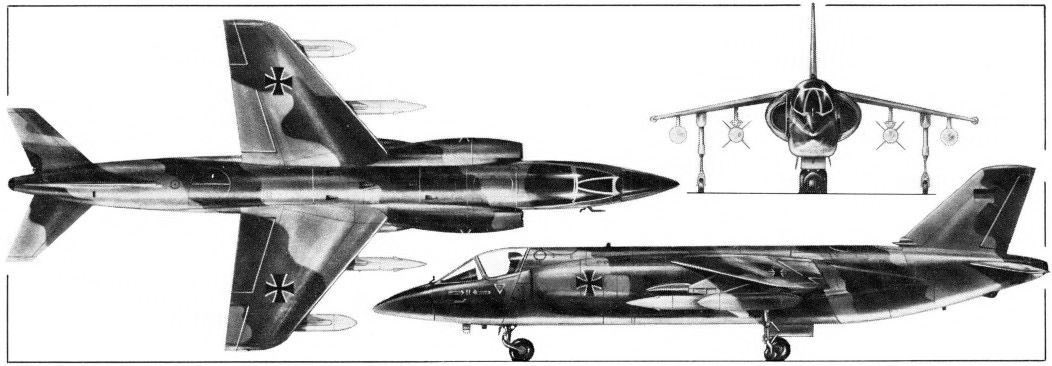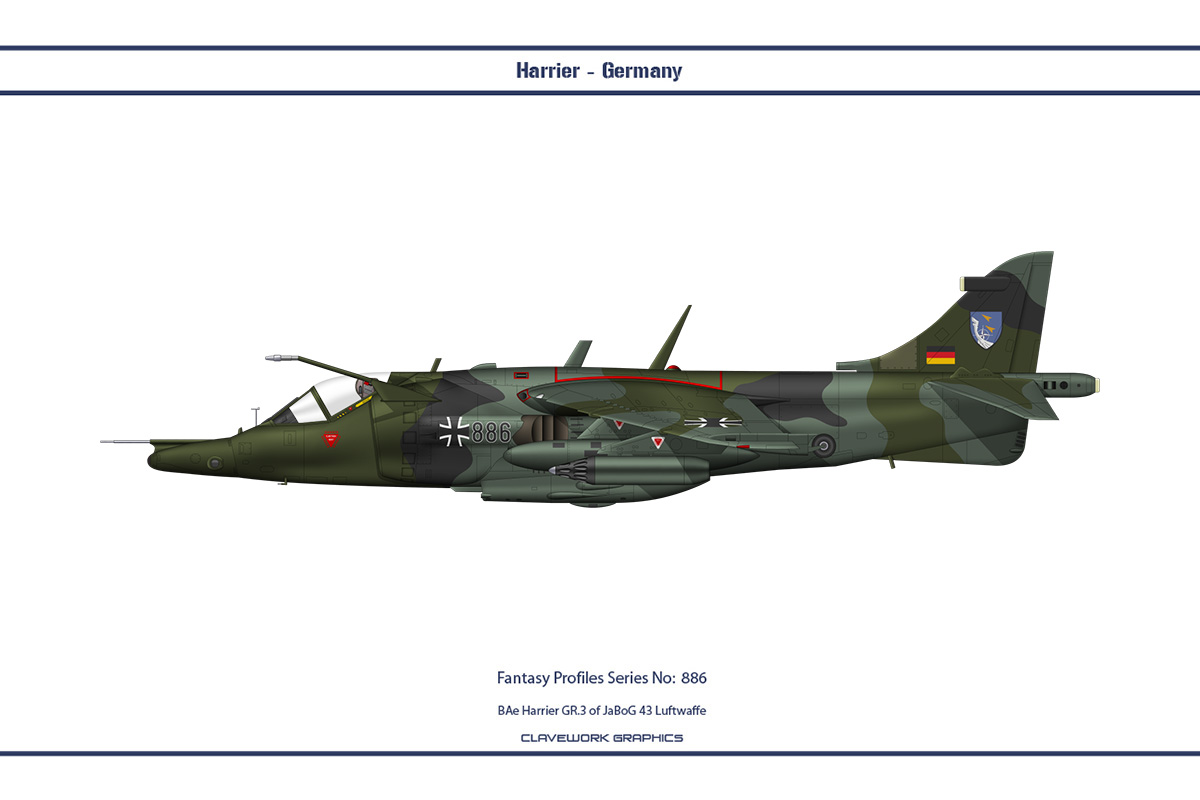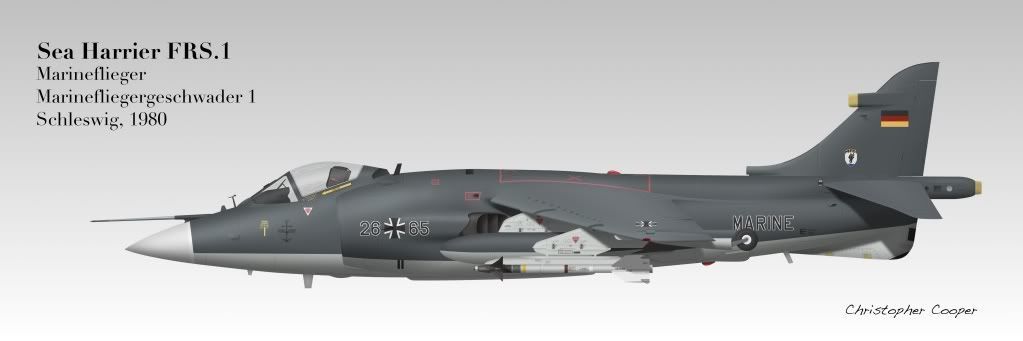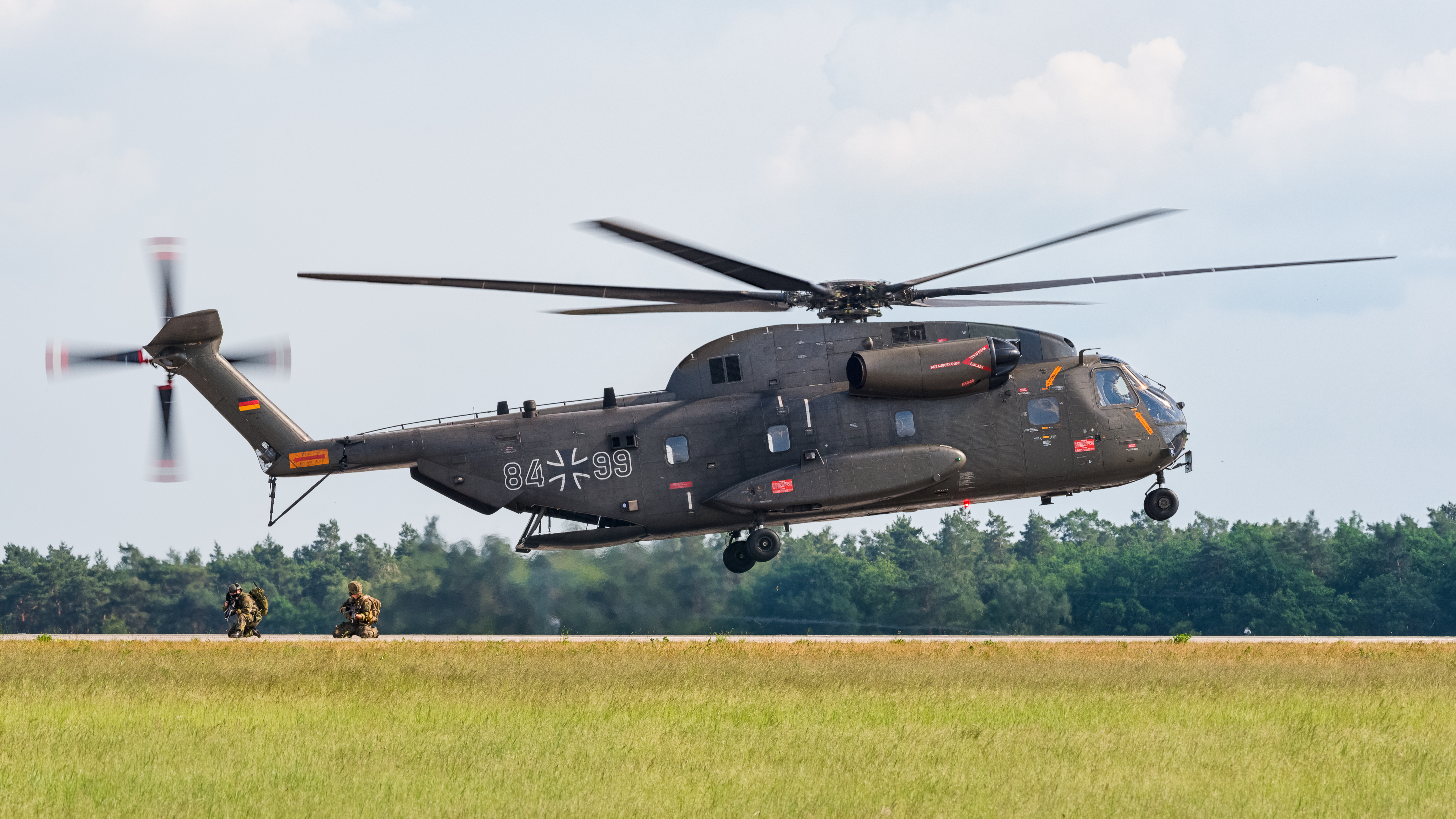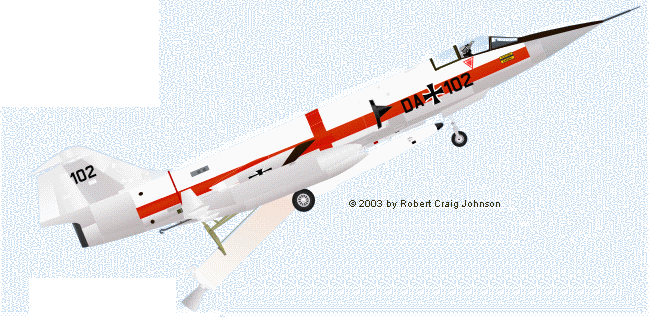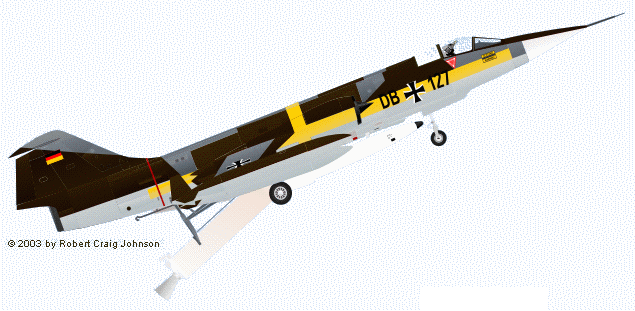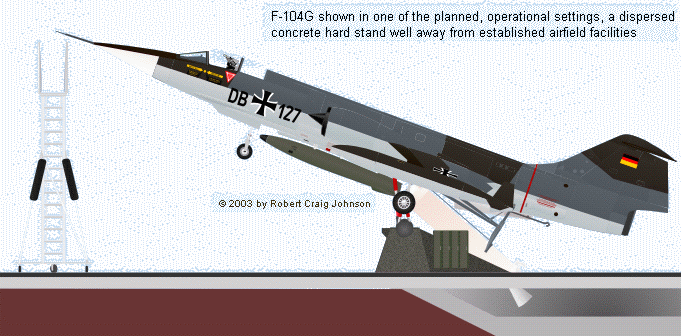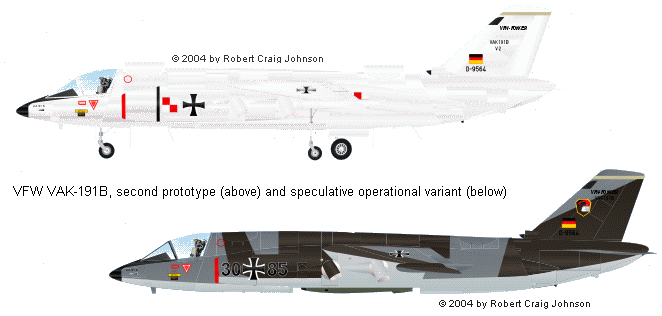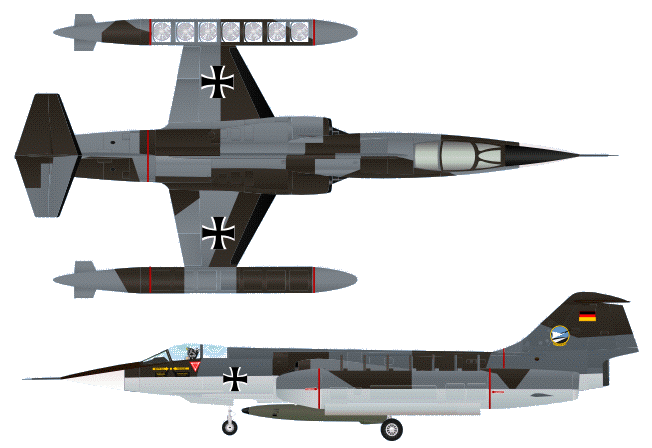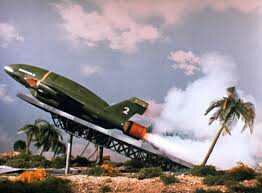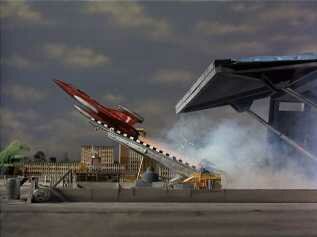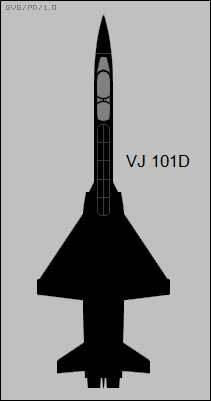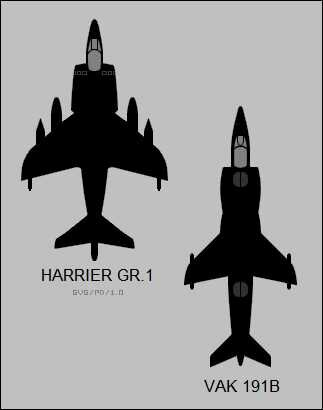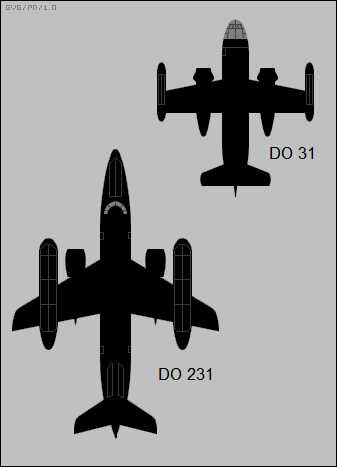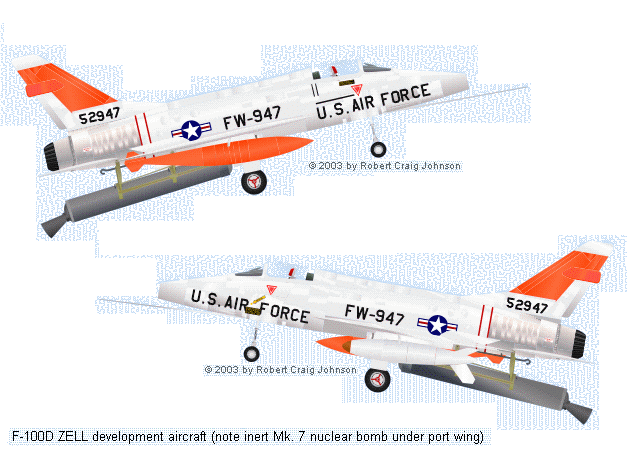The following is a piece on ZELL that I wrote for Chandelle back in 2003:
Doomsday machines: Zero-Length Launch (ZELL)
The overly cerebral, largely academic defense planning of the Cold-War years produced many fascinating and unlikely solutions for narrowly-defined or non-existent problems: launching multiengined heavy bombers from carrier decks, nuclear aircraft engines, and miniature parasite fighters riding in bomb bays all had their supporters. Of all of these schemes, Zero-Length Launch (ZELL) was among the best thought out, the most successful technically, and the least relevant to practical, real-world air force operations.
Western defense policy during the half-century following the Second World War was founded on belief that, at any moment, vast Soviet hoardes might sweep through the Fulda Gap and across the German plain to the Channel. According to the articles of this now curious faith, Soviet manpower reserves were so limitless, her heavy industrial capacity so great, and the militarization of her society so complete that the West could never hope to stop the Soviet juggernaut by opposing it man-for-man and tank-for-tank. After WW2, America was supposedly too tired of war to spend the money and lives required, and Europe was too enfeebled. To stave off defeat, the West would have to use nuclear weapons early and in quantity. When the idea was first broached, it seemed to solve all of the West's defense problems. America and Britain had a monopoly on the bomb and and overwhelming superiority in the air. Western air forces could stop the Red tank hoardes long before the latter could overrun Western air bases, and the primitive Soviet air forces could do little about it. By the late 1950s, however, this strategy had much less to recommend it: the Soviets had developed their own nuclear weapons, together with the tactical aircraft and missiles to deliver them. NATO's nuclear-armed tactical aircraft operated from the concrete runways, taxiways, and hardstands of a few, big bases, located just minutes, by ballistic missile, from the eastern frontier.
If Western air superiority was to remain the key to the defense of Europe, then, something would have to be done to eliminate the vulnerability of NATO's airplanes and bases. The USAF had always preferred to protect its aircraft from being destroyed on the ground by shooting down the attackers before they could attack. Unfortunately, no one could shoot down a ballistic missile. Traditional methods, such as dispersal and revetments, were also difficult in a nuclear environment, since the weapons might be powerful enough to destroy everything on an air field, including the vital runways.
One solution was to abandon the big, well-known air fields in wartime and disperse the aircraft across the country. In 1954, Supreme Allied Commander, Europe (SACEUR) drafted a NATO Basic Military Requirement for an lightweight tactical fighter capable of lifting a tactical nuclear bomb from unimproved roadways and grass strips. This concept, which eventually gave rise to the Fiat G.91R, was highly attractive to the US Army and to budget-conscious European governments, but it was anathema to the USAF. The lightweight fighters sacrificed too many capabilities, in its judgement, and would prove unable to carry out the mission in the face of more sophisticated enemy interceptors. Operating from fields and roads would be far too difficult and costly to be a matter of routine. The airplanes would still require fuel, ordinance, ground crews, and maintenance equipment, all of which would be expensive to provide off base. And where would you put the barracks, the batchelor officer's quarters, the clubs, and the BX? Yet, if you normally operated from the existing bases and dispersed only in wartime, what did you gain? Nuclear-armed missiles could still destroy the base before you could disperse.
Another solution was to accept that airplanes and air forces had become irrelevant, given the posited threat, a position that Britain adopted in the famous 1957 Defense White Paper. This held that, in a nuclear war, the ballistic missile had made the aircraft obsolete. Ballistic missiles could be launched from hardened nuclear-bomb resistant shelters or dispersed on trucks. They were, for the specialized nuclear missions being considered, cheaper to develop and deploy. They could not be intercepted, and they could, in principle, be launched at much shorter notice than aircraft. Needless to say, from a USAF point of view, this was worse than the lightweight fighter idea. If adopted, it would end the air force as it had been known to date and convert it into a sort of artillery arm, limited to the delivery of nuclear shells.
One could also develop specialized aircraft optimized for vertical takeoff and landing (VTOL) from dispersed sites. SACEUR and the Federal German Government pursued this option as a follow-on to the lightweight fighter program. But most of the USAF objections to the lightweight fighter applied doubly to VTOL aircraft. The compromises that runwayless operation demanded would alway result in an airplane that was less capable and less flexible in other respects when compared with conventional fighters. The problems of fueling, maintenance, and accommodations were exactly the same.
While the Air Force could cavalierly dismiss the solutions proposed, it could not so easily disregard the threat posed to its bases by Soviet nuclear missiles, particularly given the concerns expressed by SACEUR. The G.91 program showed that, at the very lest, SACEUR was capable of going around the USAF to get its concerns addressed. The practice of maintaining nuclear-armed aircraft on "hot-stand" alerts, with engines idling and crews in the cockpit substantially reduced the time needed to launch a strike, but it did not eliminate the need for advance warning. So a requirement emerged for a system that would let the Air Force have change everything while changing nothing. The USAF needed a system that would let any aircraft in the USAF inventory operate from shelters and dispersed sites without compromising any of the aircrafts' other qualities, without imposing special burdens on aircraft designers, and without threatening the Air Forces established infrastructure, processes, and overalll way of doing things. This system was ZELL.
Superficially, the ZELL concept was simple extension of the familiar JATO rocket-assisted takeoff idea. JATO bottles were routinely used to launch heavily loaded aircraft. They came in standard sizes, and all service aircraft likely to use them came with built-in provision for mounting them. While more expensive and troublesome than a conventional takeoff, a JATO launch was less expensive than building-in a heavy-load takeoff capability that would be used only occasionally in service. JATO was thus an excellent compromise. To extend the concept for the dispersed operations mission, one would only have to provide bigger rockets, so that the takeoff run would be less than the length of the aircraft's fuselage: zero-length launch. Any aircraft in the USAF inventory could then be fired off the back of a truck or out of a concrete bunker in the woods, just like a ballistic missile. Or so it seemed.
In practice, there was rather more to it. JATO differed from the proposed ZELL concept in that it merely accelerated the aircraft to wingborne flying speed more quickly and thus shortened the takeoff roll. ZELL proposed to do away with then takeoff roll altogether. The aircraft would be launched ballistically and would be well on their way before their engines and wing-generated lift had anything to do with it. This took a lot of thrust, depending on the launch weight of the aircraft. Standard JATO-style rockets would not now work, since the thrust would have to be separately calculated for each aircraft type and load option. To achieve a smooth transition to stable, controlled flight, engineers had to calculate the thrust line of the rocket in relation to the centers of gravity and lift for each aircraft type as well. This meant that the mountings could not be standard either. Handling the rocket motors in addition to aviation fuel, ground equipment, the aircraft itself, and the ordinance complicated the problem of operating from dispersed sites.
Nonetheless, the launch concept worked well. Early experiments with a Republic F-84G showed that the airplane could be launched smoothly and at a reasonable rate of acceleration. Pilots had no difficulty making the transition to controlled flight, although the uncontrolled ballistic takeoff was not universally popular. Trials were later extended to include the standard USAF tactical fighter of the period, the F-100 Super Sabre. These were again considered successful. Using a Rocketdyne booster offering 130,000 pounds (59,000 kg) of thrust, An F-100D with external fuel and a Mk.7 tactical nuclear bomb could reach 275 mph (450 KPH) and 400 ft (120 m) in 4 seconds, for a maximum acceleration of 4G. The aircraft could be launched in as little as 5 minutes, and it allowed the aircraft to operate at night and in almost any weather.
Landing concepts were another matter. At first, ZELL proponents planned to use the Matt Landing (MAL) approach to recover ZELLed aircraft. This required that the aircraft land wheels up on a special, inflatable rubberized landing mat, 80 ft wide, 800 ft long, and 3 feet thick (25x245x1 m) and stop short by means of an arrester hook and cable. The flexible mat was supposed to cushion the shock of landing enough to obviate the need for a heavy, aircraft carrier-type landing gear and structure. When MAL was first tried, using the F-84G, it was a disaster. The aircraft bounced wildly, the arrester hook tore the mat, and the aircraft was destroyed. The test pilot suffered severe spinal injuries. The next two tests went somewhat more smoothly, but it was obvious that pilots risked serious whiplash injuries every time the technique was used. The MAL approach was, moreover, unacceptably clumsy, complex, and labor intensive. The huge mat was awkward to transport and slow to deploy. The approach was abandoned.
For the USAF, the failure of MAL was not a serious drawback. The service viewed the ZEL technique as a way of addressing the airfield-vulnerability issues raised by SACEUR without in any way compromising on the qualities it wanted in its fighter aircraft. It did not seriously contemplate using ZELL for routine flight operations. ZELL would be used, if at all, in the aftermath of a massive, nuclear surprise attack. In this Doomsday scenario, the Air Force reasoned, a short-field recovery method was not really needed: the pilot could simply return to friendly territory and eject. ZELL was therefore accepted for limited operational use, and the remaining F-100D airframes on the North American production line—100 or so—were delivered with full, operational ZELL equipment, standard.
The USAF did not subsequently deploy or practice ZELL with the F-100 or any other aircraft, however. By the time it was ready, having nuclear-armed combat aircraft trundling around the countryside on the backs of trucks did not seem like such a good idea. Providing adequate security for the weapons would have been almost impossible, and European citizens were beginning to be less tolerant of the damage and annoyance caused by major, peacetime NATO deployments. European governments were also have second thoughts about the wisdom of using nuclear explosions on or near their own territory to blunt a Soviet attack.
Interest in ZELL did not end with the USAF, however. Of all the NATO air forces, the Federal German Luftwaffe was the only one to take SACEUR and NATO's Massive Retaliation strategy really seriously. It had, for instance, been the only NATO country to deploy the G.91R lightweight fighter in quantity. This attitude is understandable. As a quick look at a map shows, the Federal Republic was simply too shallow for a defense based on conventional weapons to succeed. A defense that finally stopped the Soviets in Belgium would do Germans little good. Flexibility and conventional weapons-carrying was, moreover, of little interest to the Germans. They did not have the extensive overseas committments of the United States, Great Britain, and France, and they did not produce aircraft for export to secondary powers, as these countries did. Specialization and almost complete reliance on nuclear arms were thus not the problem for Germany that they were for these other powers.
Germany's massive investment in the Lockheed F-104G Starfighter also made the ZELL technique attractive. The F-104G was a variant of the F-104A high-altitude, clear-weather interceptor strenghtened and optimized for nuclear bombing at high-speed and very low altitudes, where contemporary air-defense radars were ineffective. It was well suited for this role primarily because it had a tiny, short-span, razor-thin wing originally designed for high turn rates at supersonic speeds and high altitudes. In the thick, bumpy air at low altitude, a large, flexible, and/or long wing vibrates so badly at high speeds that airframe parts break and pilots cannot function. Gusts and downdrafts can force such aircraft to flyer high enough or slow enough to make them vulnerable to enemy defenses. The F-104's stiff, short-span wing was much less affected. However, it also offered much less lift, even after the basic F-104 design was modified to include larger, more effective flaps. Takeoff runs were comparatively long, so it was hard to launch the aircraft really quickly, as nuclear strike scenarios demanded. ZELL was, for this reason alone, very attractive. While dispersing the aircraft around the country on trucks was now out of the question, it might still be possible to disperse the aircraft well-enough within the confines of military bases, especially if they could be launched from a hardened rock or concrete shelter. Tests with the F-100D had showed that the shelter-launch idea was perfectly feasible. In many ways, it made the logistics of ZELL and the process of carrying out a really quick launch easier, particularly in bad weather.
With partial German funding, ZELL development was thus resumed in 1963. Initially, the work was carried out at Edwards Air Force Base in the USA, using a German-owned F-104G from JBG 31, DA+102 (683-2002), the third Lockheed-built airframe. The aircraft was launched carrying a simulated, 1-megaton B-43 tactical nuclear weapon and a full load of external fuel, four 348-gal (1287-ltr) tanks, two on the wing tips and two under wing. Once again, no serious difficulties were encountered.
In 1966, the test program moved to Lechfeld, Germany for final, operational tests. Two F-104G aircraft from Lechfeld-based JBG 32 (DB+127 and DB+128) were used for the next series of evaluations. This time, the aircraft were to be launched from simplified, unfortified hardstands located near the periphery of the base. Each launch position incorporated a pair of concrete pylons with fittings for the F-104G landing gear, a concrete ramp, and a shallow, concrete-lined trench to channel the rocket exhaust away from the launch pad. Special ground equipment, including high-rise boarding ladders, were provided.
To recover its aircraft at the end of their missions, the Germans planned to use the airfield arrestor gear originally developed for the US Marine Corps SATS (Short Airfield for Tactical Support) system. SATS essentially recreated an aircraft carrier flightdeck ashore, using interlocking aluminum deck panels, a portable catapult, and hydraulic cable-arrest system. In wartime, these would be deployed to remote or disused airfields or along the autobahnen.
Like its USAF predecessor, however, the German ZELL program gradually faded away, after a lengthy series of completely successful tests. The high cost of the rockets was probably a factor, as were the increasing unpopularity of nuclear arms in Germany during the '60s and the increasing accuracy of ballistic missiles. No one was still prepared to disperse live nuclear weapons across Germany's fields and parking lots. Yet the presumed accuracy and high capacity of Soviet IRBMs made it unlikely that any practical level of hardening could save an aircraft in a concrete shelter. In all probability, the decision to use SATS for recovery further undermined the program. Once the additional complexity of the airfield arrestor system was accepted, the need for the ZELL rocket became questionable: the full SATS system included a catapult that was already in use by the US Marines. The Luftwaffe in fact experimented with catapult launching the F-104 at one point in the program. Changing political and diplomatic realities had, however, rendered simplistic nuclear doomsday scenarios obsolete by this point. Even Germany had lost interest in short-takeoff, quick reaction nuclear attacks. The program quietly died.
In the final analysis, ZELL exemplifies the weaknesses of a Western defense establishment that too often focused on technological possibility rather than operational necessity. ZELL addressed a largely theoretical threat and failed to allow for the day-to-day, real-world realities of owning and operating military aircraft. It ignored costs, operational issues, and the organizational problems it caused for the user services. ZELL's creators set themselves the task of producing a radical new capability without any thought for how their invention would complement the existing inventory or change existing procurement plans. They gave the Air Force's conventional aircraft a bolt-on STOL capability, obviating the any discussion of whether STOL was needed and, if so, whether conventional aircraft were the best way to provide it. Worse still, the superficial flexibility of the system was illusory. It merely allowed the USAF to convert any multipurpose aircraft into a rigid, single-purpose nuclear delivery system. ZELL could not be easily adapted to more conventional military roles, if only for center-of-gravity reasons: a different bolt-on booster package would have to be designed, qualified, and stocked for every type of tactical aircraft, weapons loadout, and operating weight that might be encountered operationally. Pilots would have to be trained for both ZELL and conventional operations, and new bases and support equipment would have to be provided in parallel with those needed for normal runway operations. ZELL thus nullified the main advantages of tactical aircraft: flexibility, adaptability, and relative economy of operation. ZELLed aircraft could not be rapidly switched from one role to another. Takeoff and much of the flight to the target were under automatic control, so the expensively trained pilot was just a passenger. During recovery, if the scenario went as expected, his skills would not even be needed to land the aircraft, because all of the NATO air bases would be gone and he would be ejecting. ZELL's creators had, in effect, turned a jet fighter into an overweight, under-performing, over-priced cruise missile.
From Chandelle 8:1. Text and illustrations © 2003 by Robert Craig Johnson. All rights reserved.

